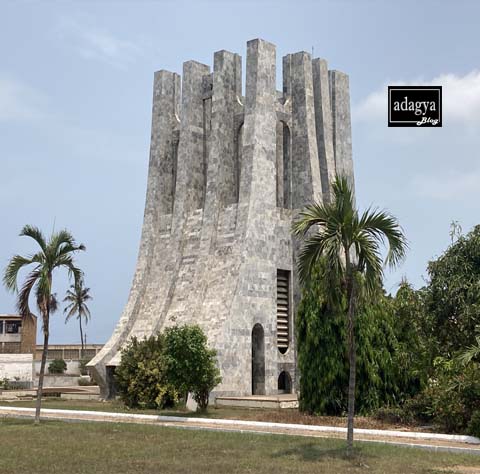
The Kwame Nkrumah Mausoleum and Memorial Park was the point where Nkrumah declared independence in 1957 and is now the final resting place of Nkrumah and his wife. The park consists of five acres of land and holds a museum tracing Nkrumah’s life, displaying items from his childhood, through his teenage years to his adult life.
Things To Do, Location And Entry Requirements To Kwame Nkrumah Mausoleum and Memorial Park
Location and which year was Kwame Nkrumah Mausoleum built?
The mausoleum built in marble is situated at the former British Colonial Polo grounds. The mausoleum on the five (5) acre land was designed by Don Arthur and dedicated in 1992 to the prominent late Ghanaian president Osagyefo Dr. Kwame Nkrumah.
Read also… Kwame Nkrumah Mausoleum: Renovated Gallery Of The Monument
Who was Kwame Nkrumah?
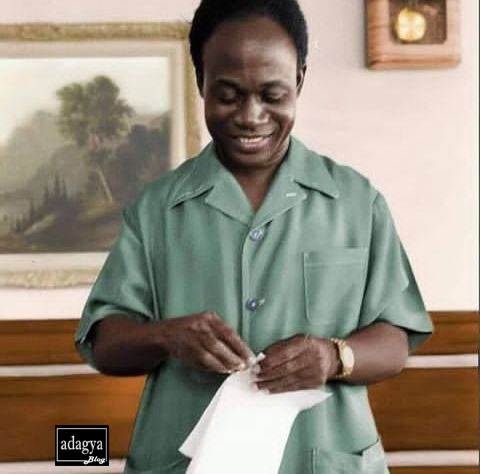
Kwame Nkrumah was the first prime minister from the year 1957 to 1960 and became the president of the Republic of Ghana in 1960 to1966. He was the leader of the first sub-Saharan African nation to gain its independence from colonialism. He subsequently became the main figure in the campaign for the United States of Africa.
Kwame Nkrumah was born on 21st September 1909, in Nkroful in the Western Region of Ghana (Gold Coast) by Madam Elizabeth Nyaniba and Mr. Kofi Ngoloma. The son of a goldsmith, he attended mission schools at Accra and government training colleges at Achimota in 1926 where he prepared to be a teacher.
In 1935, Nkrumah left for the United States where he attended Lincoln University (1935-1939) and the University of Pennsylvania (1939-1943). A gifted student, by 1943 Nkrumah had earned multiple bachelor’s and master’s degrees in economics, sociology, education, theology, and philosophy. Then, in May of 1945, Nkrumah departed for London, England, where he studied as a PhD student at the London School of Economics.
While in London, Nkrumah held key positions in anti-colonialist and black-nationalist organizations and authored controversial papers calling for African independence and unity. In 1945, Nkrumah co-founded the Pan African Congress, which became an influential voice against colonialism in Africa.
In 1947, Nkrumah returned to the Gold Coast and became general secretary of the newly-founded United Gold Coast Convention. However, in 1949 Nkrumah split with the organization over its political objectives and formed the Convention People’s Party (CPP).
During his tenure as head of the CPP, Nkrumah protested British rule and led numerous petitions for self-government. Imprisoned by the British in 1950 for his political activities, Nkrumah was released in 1951 when his party won the general election in a landslide victory. He subsequently was elected prime minister in 1952.
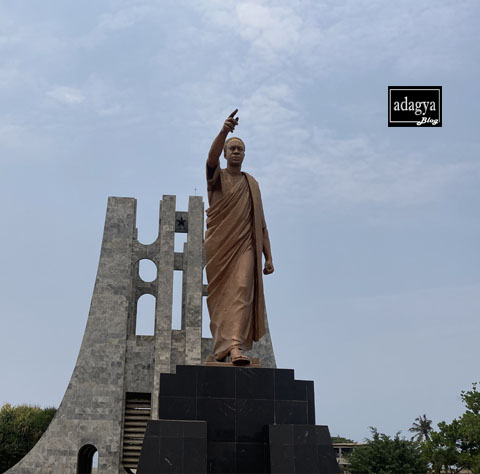
As prime minister, Nkrumah led an aggressive campaign for independence and achieved it in 1957. Three years later, he formed a new government, the Republic of Ghana. A devoted Pan-Africanist, Nkrumah forged alliances with both Guinea and Mali, and sought to create a league of African states with its own government.
To help achieve this goal, in 1963 he and other African leaders formed the Organization of African Unity. Choosing to remain neutral in political affairs outside of the African continent, Nkrumah initially gained tentative support from both the United States and Soviet Union, receiving economic and technical aid from both countries.
Vigorously suppressing political dissidents, Nkrumah almost immediately was branded a dictator by his political opponents. Then, in 1961 a firestorm of protest erupted after he appointed himself supreme commander of the armed forces and absolute head of the CPP. Nkrumah subsequently outlawed all other political parties.
In 1966, Nkrumah’s government was overthrown by a coup d’état while he was on a trip to Beijing, China. Taking refuge in Guinea, he was made a co-president in the country for his great leadership skills. Nkrumah spent the rest of his life in exile. He died in Bucharest, Romania on April 27, 1972 while responding to treatment for cancer.
On 7th July 1972, the mortal remains of Osagyefo Dr. Kwame Nkrumah was brought to Ghana after burial ceremony was held for him. Nkrumah married to an Egyptian lady called Madam Fathia and had four (4) children.
Where is Nkrumah buried?
Finally Kwame Nkrumah’s body is resting at the Kwame Nkrumah Mausoleum at the Memorial Park. The park is encapsulated into three categories namely: The Fountain, The Mausoleum and the Museum.
What does the Kwame Nkrumah Mausoleum contain?
The Fountain
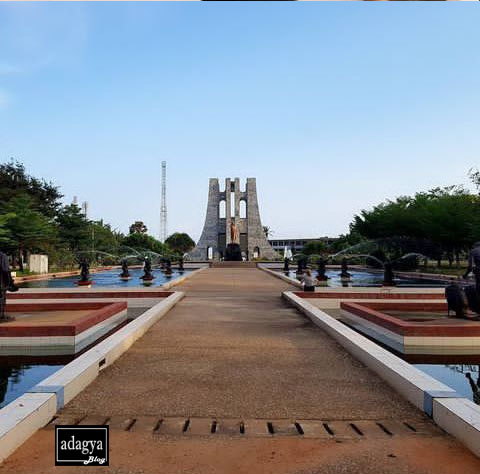
The fountain is located directly opposite the former parliament house of Ghana, now serving as the office of Commission on Human Rights And Administrative Justice (CHRAJ). As Nkrumah was a music lover, the water fountain has 7 horn blowers on each side with the numbers standing for perfection. They are blowing the horn to announce the death of Osagyefo Dr. Kwame Nkrumah. There is also a guitarist and a drummer also playing their instrument to welcome you to the burial grounds of the late president.
The water in the fountain which is an indication of life symbolized that though Nkrumah is dead but his spirit still lives with us.
The Mausoleum
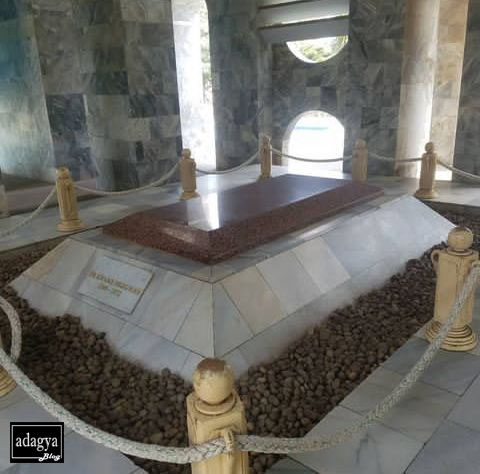
In front of the mausoleum is the statute of the late president. It is made of brass standing erect with his finger pointing forward ever during the declaration of Ghana’s independence.
Inside the mausoleum are two tombs for Osagyefo Dr. Kwame Nkrumah and his wife Madam Fathia Nkrumah.
The mausoleum is an architectural building, which as said earlier was designed by Don Arthur and built a Chinese in Italian marbles. The mausoleum is shaped like truncated tree which alludes to the uncompleted work of Dr. Kwame Nkrumah. In the Ghanaian culture, when a farmer is tired of his day’s labor, he finds a shade from a big tree. So the building is a sympol of Kwame Nkrumah resting under a tree after his hard day of work.
The building also looks like a sword turned upside symbolizing peace. It has also a black star on top of it which is an inspiration from Marcus Garvey which is the hope for Africa.
The Museum
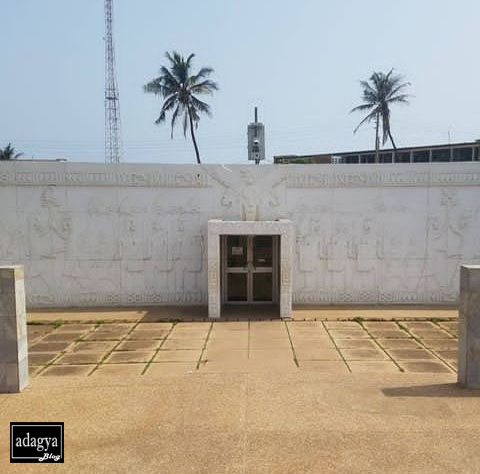
The museum which is the final part of the Kwame Nkrumah memorial park has a vandalized statute of the late African leader in front. The statute was in front of the old parliament house and after the coup on February 24th 1966, it was vandalized. Around 28th May, 2009, some patriotic citizens presented it to the park for exhibition. It was mounted on 1st September same year it was presented.
The museum building has some Ghanaian drawings on them which look Egyptian. It has some drawing of an eagle which is a symbol of power, so the adage unity is strength, a man holding a staffwhich stands for authority and a woman holding an egg which shows how fragile power is.
Also is a flamingo stretching its neck to pick something from the behind which is locally known as ‘’sankofa’’ meaning going back to the root. There are other drawings which all depict the various cultures in Ghana.
Inside the museum are artifacts which were used by Osagyefo Dr. Kwame Nkrumah like his piano, presidential office desk, the casket he was laid in, books written by him, dressing mirror, the set of furniture he used, pictures of him and other dignitaries like John F. Kennedy, Queen Elizabeth, and others.
Also in the park is an exhibition of the car he used during his presidency.
Now the Nkrumah mausoleum is serving as a tourist attraction to visitors.
Getting There
The memorial park is located in the center of Accra near the Arts Center and few distance walk from the Black Star (Independence) Square.
Working Hours
The park is opened daily between 08:00 am to 17:00 pm
Entrance fees (Rates)
Visitor Category Entrance Fee (GH¢)
- Ghanaian Children 1.00
- Ghanaian Teenagers 2.00
- Ghanaian Adults 3.00
- Non-Ghanaian Children 2.00
- Non-Ghanaian Teenagers 5.00
- Non-Ghanaian Adults 10.00
Nearby Attractions:
Art Center
Ussher Fort
Accommodation near the facility
Get accommodations near the facility here.
